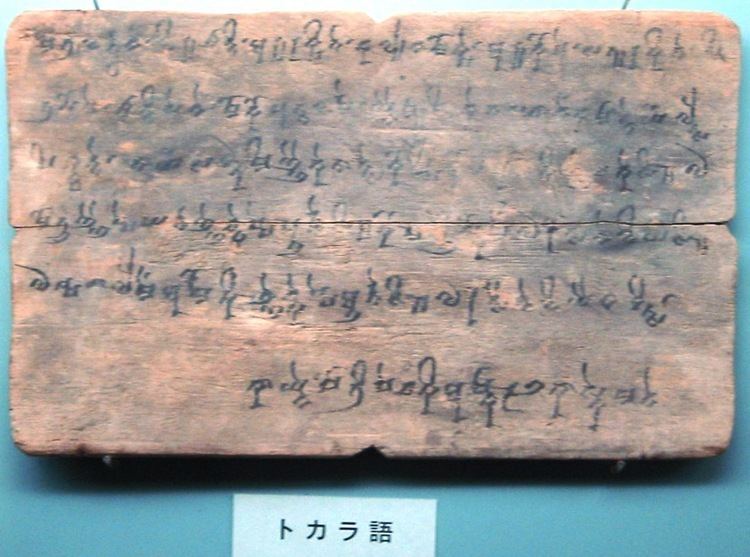Type Abugida Time period 8th century | Languages Tocharian language Sister systems Gupta, Pallava | |
 | ||
Parent systems Proto-Sinaitic alphabet
Phoenician alphabet
Aramaic alphabet
Brāhmī script
Tocharian script | ||
The Tocharian alphabet is a version of Brahmi script used to write the Central Asian Indo-European Tocharian languages, mostly from the 8th century (with a few earlier ones) that were written on palm leaves, wooden tablets and Chinese paper, preserved by the extremely dry climate of the Tarim Basin. Samples of the language have been discovered at sites in Kucha and Karasahr, including many mural inscriptions.
Tocharian A and B are not mutually intelligible. Properly speaking, based on the tentative interpretation of twqry as related to Tokharoi, only Tocharian A may be referred to as Tocharian, while Tocharian B could be called Kuchean (its native name may have been kuśiññe), but since their grammars are usually treated together in scholarly works, the terms A and B have proven useful. A common Proto-Tocharian language must precede the attested languages by several centuries, probably dating to the 1st millennium BC. Given the small geographical range of and the lack of secular texts in Tocharian A, it might alternatively have been a liturgical language, the relationship between the two being similar to that between Classical Chinese and Mandarin. However, the lack of a secular corpus in Tocharian A is by no means definite, due to the fragmentary preservation of Tocharian texts in general.
The alphabet the Tocharians were using is derived from the Brahmi alphabetic syllabary (abugida) and is referred to as slanting Brahmi. It soon became apparent that a large proportion of the manuscripts were translations of known Buddhist works in Sanskrit and some of them were even bilingual, facilitating decipherment of the new language. Besides the Buddhist and Manichaean religious texts, there were also monastery correspondence and accounts, commercial documents, caravan permits, and medical and magical texts, and one love poem. Many Tocharians embraced Manichaean duality or Buddhism.
In 1998, Chinese linguist Ji Xianlin published a translation and analysis of fragments of a Tocharian Maitreyasamiti-Nataka discovered in 1974 in Yanqi.
Tocharian script probably died out after 840, when the Uyghurs were expelled from Mongolia by the Kyrgyz, retreating to the Tarim Basin. This theory is supported by the discovery of translations of Tocharian texts into Uyghur. During Uyghur rule, the peoples mixed with the Uyghurs to produce much of the modern population of what is now Xinjiang.
The Tocharian Script
The Tocharian script is based on Brahmi, where each consonant has an inherent vowel, which can be altered by adding a vowel mark, or removed with a special nullifying mark, the virama. Like Brahmi, Tocharian uses stacking for conjunct consonants, and has irregular conjunct forms of , ra.
